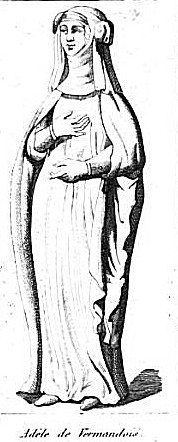Adelaide | |
|---|---|
 Depiction of Adelaide of Vermandois in the 19th century book Histoire générale de France depuis les temps les plus reculés jusqu'a nos jours | |
| Died | 1120 or 1124 |
| Noble family | Carolingian dynasty |
| Spouse(s) | Hugh I, Count of Vermandois Renaud II, Count of Clermont |
| Father | Herbert IV, Count of Vermandois |
| Mother | Adele of Valois |
Adelaide of Vermandois (died 23 September 1120) was suo jure Countess of Vermandois and Valois from 1080 to 1102. She was the last landed ruler of the Carolingian dynasty.
Contents
Adelaide was the daughter of Herbert IV, Count of Vermandois and Adele of Valois. [1] [2]
By 1080, [3] Adelaide married Hugh, son of the Capetian King Henry I of France and younger brother of Philip I of France. [4] Hugh became Count of Vermandois, following Adelaide's father's death. [a] [5]
In 1104, Adelaide married Renaud II, Count of Clermont-en-Beauvaisis. [6] By this marriage, Adelaide had a daughter, Margaret of Clermont.
In 1102, Adelaide was succeeded by her son, Ralph I. Adelaide died in 1120, being the last Carolingian to hold the County of Vermandois.